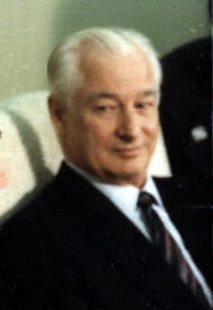Jose Azcona Hoyo
| José Azcona | |
|---|---|

Azcona in 1987
|
|
| President of Honduras | |
|
In office 27 January 1986 – 27 January 1990 |
|
| Vice President | Alfredo Fortín |
| Preceded by | Roberto Suazo Córdova |
| Succeeded by | Rafael Leonardo Callejas |
| Personal details | |
| Born |
José Simón Azcona del Hoyo 26 January 1927 La Ceiba, Atlántida Department, Honduras |
| Died | 24 October 2005 (aged 78) Tegucigalpa, Honduras |
| Nationality | Honduran |
| Political party | Liberal Party of Honduras |
| Spouse(s) | Miriam Bocock |
| Alma mater | University of Monterrey |
| Profession | Businessman, politician |
José Simón Azcona del Hoyo (26 January 1927 – 24 October 2005) was President of Honduras from 27 January 1986 to 27 January 1990 for the Liberal Party of Honduras (PLH). He was born in La Ceiba in Honduras.
Azcona spent the years from 1935 to 1949 living in Cantabria, Spain with his maternal grandparents. He grew up there during the Spanish Civil War. He returned to Honduras in 1949, working in his family's trading company. He then went to study in the National Autonomous University of Honduras (UNAH) graduating in civil engineering, with postgraduate studies from the University of Monterrey in Mexico.
As the PLH were unable to decide on a single candidate they ended up fielding four candidates, including Azcona, against the one National Party of Honduras (PNH) candidate Rafael Leonardo Callejas Romero. Because the PLH candidates gained 51.5% of the vote between them, and as Azcona gained the highest of the 4, he gained the presidency with only 27.5% of the vote, even though Callejas gained 42.6% of the vote. This was the first transfer of power from one constitutional, elected president to another since 1948, and the first time it happened democratically since 1932.
Azcona's success as a president has been contested across the political spectrum. While his followers and a large proportion of the population would favour him due to the perceived honesty and integrity of his government, another group would challenge this view, arguing that he pursued a weak economic policy (artificially maintaining a 2:1 exchange rate between the Honduran lempira and the US dollar), ran up large budget deficits and did little to develop investment opportunities in the country. Many people still remember the fuel supply problems, mostly in the last part of his government due to foreign credit issues.
...
Wikipedia
